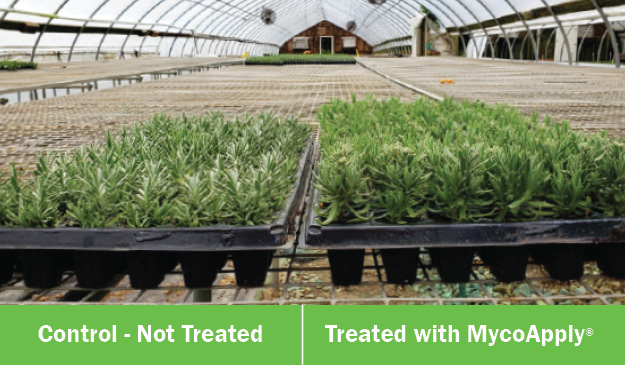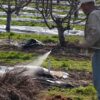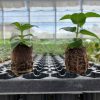As we are often told in life, timing is everything. As I am writing this article, the timing I am referring to is the need to act now. Now is the time to make the strategically important decision to start to use mycorrhizae for your 2024 crops. The decision to purchase now and the decision to use mycorrhizae can positively impact your company’s Spring 2024 bottom line.
Timing Topic #1 Fall Booking Program: Now through the end of November, Mycorrhizal Applications offers our products purchased by growers, landscapers, and turf professionals at a discount when they are purchased through our distributor and dealer network. Generally, if you place your order by mid-November with your distributor, you should be able to qualify for these discounts.
Timing Topic #2 Experience has shown that applying mycorrhizae during propagation is the best time for application. This statement is supported by four points:
- Minimize the cost to the grower – If you treat a seeded plug or a cutting cell with mycorrhizae, you only need to treat that volume of soil. If you wait to apply your treatment to the time you transplant into your finishing soil mix, then you must treat the now larger volume of soil. Treating smaller volume containers requires less mycorrhizae either via soil inclusion or drench, thus lowering your cost to treat. Following this strategy, you can treat a 72-cell liner cell for a little over $0.01 cents per plant. Since you only need to treat plants once with mycorrhizae and the mycorrhizae transfers with the plant as the plant is transplanted in a larger container, the decision to treat early makes the most financial sense.
- Maximum benefit to the plant- The earlier you apply mycorrhizae, the earlier the plant can start to benefit from the relationship. This can be as early as when a cutting starts to produce adventurous roots or when a seed enters stage 2 and starts to produce roots. Once the first attachment is initiated it typically takes about 3-4 weeks before symbiosis is complete, and the plant can start to benefit from the relationship. The plant controls the relationship and turns the mycorrhizae on and off based on when it needs additional nutrients or water.
- Reduce transplant stress – Once the mycorrhizae connect to the plant roots, it immediately starts to extend its hyphal network into the soil. Mycorrhizal hyphae are 1/10th the size of root hairs and extend to areas in the soil the plants root system does not reach. These hyphae secure water and nutrients for the plant to use during times of stress. When a plant is transplanted from the plug/liner into its finishing container the plant suffers stress and often stalls in growth until the stress is overcome. Mycorrhizae treated plants use this increased root absorptive area and stored water in the hyphae and nutrients in the mycorrhizae to feed the plant and shorten this time of stress.
- Maximum benefit for the grower – The earlier you treat with mycorrhizae, the earlier the plant starts to benefit. Once this 3-4 week of plant symbiosis passes, the grower can start to see benefits from the mycorrhizae. This process typically takes another 3-4 weeks. Typically, the benefits are more noticeable when the plug/liner is transplanted into a larger soil volume container.
If you purchase plugs and rooted liners these same principles apply. Depending on your size, it makes sense to either dip your plug trays or drench your plugs/liners when they arrive. This allows you to take advantage of all four of the benefits outlined above. Additionally, if you get busy and you don’t transplant your plugs/liners immediately, the symbiosis clock is still ticking and the benefits to the plant and you as the grower will be realized sooner.
Mycorrhizae can offer a grower multiple benefits (I suggest you reference some of the other articles on this website to better understand the wide array of potential benefits), however since this article is focused on timing, I want to talk about the potential impact of mycorrhizae use on crop time.
Mycorrhizae use has the potential to reduce crop time. This can be up to one week in an 8–10-week crop. Or maybe up to two weeks in a 10–14-week crop. Tree and shrub growers can often take a year or more off the production clock by using mycorrhizae. Plants with less stress focus on growing rather than on surviving and complete their growth stage sooner. The resulting plants are ready for retail sales sooner.
As I started this article talking about time, I will finish it by talking about time. Simply said, production time costs money, if you can shorten it by using mycorrhizae you can reduce your costs well beyond the minimal additional input costs from the use of the mycorrhizae.
Now is the time to decide to choose to use mycorrhizae on your 2024 crop.
Now is also the time to purchase your MycoApply mycorrhizae so you can get the best price and have it ready for use during your 2024 propagation season.
If you have any questions about anything covered in this article or MycoApply Mycorrhizae, please contact your local Mycorrhizal Applications Representative or call 866-476-7800 or email us at inquiries@mycorrhizae.com.
Article by: Blair Busenbark
Mycorrhizal Applications – Sales and Commercial Marketing Manager
October 30, 2023







